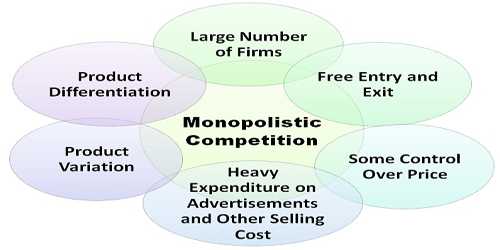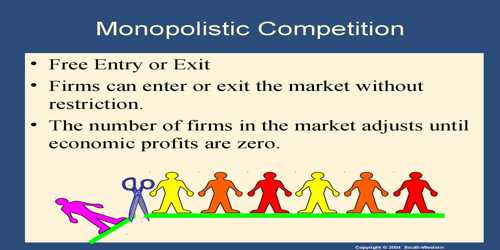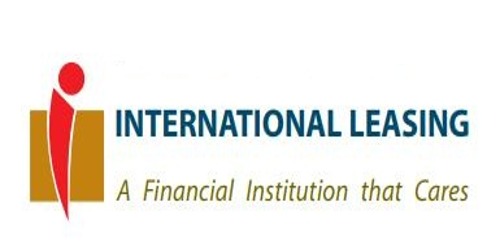Monopolistic market competition is a type of imperfect competition such that competing producers sell products that are differentiated from one another as good but not perfect substitutes (such as from branding, quality, or location). In monopolistic competition, a firm takes the prices charged by its rivals as given and ignores the impact of its own prices on the prices of other firms.
In a monopolistically competitive market, firms can behave like monopolies in the short run, including by using market power to generate profit. In the long run, however, other firms enter the market and the benefits of differentiation decrease with competition; the market becomes more like a perfectly competitive one where firms cannot gain economic profit. In practice, however, if consumer rationality/innovativeness is low and heuristics are preferred, monopolistic competition can fall into natural monopoly, even in the complete absence of government intervention. In the presence of coercive government, monopolistic competition will fall into government-granted monopoly. Unlike perfect competition, the firm maintains spare capacity. Models of monopolistic competition are often used to model industries. Textbook examples of industries with market structures similar to monopolistic competition include restaurants, cereal, clothing, shoes, and service industries in large cities. The “founding father” of the theory of monopolistic competition is Edward Hastings Chamberlin, who wrote a pioneering book on the subject, Theory of Monopolistic Competition (1933). Joan Robinson published a book The Economics of Imperfect Competition with a comparable theme of distinguishing perfect from imperfect competition.
Monopolistically competitive markets have the following characteristics:
- There are many producers and many consumers in the market, and no business has total control over the market price.
- Consumers perceive that there are non-price differences among the competitors’ products.
- There are few barriers to entry and exit.
- Producers have a degree of control over price.
The long-run characteristics of a monopolistically competitive market are almost the same as a perfectly competitive market. Two differences between the two are that monopolistic competition produces heterogeneous products and that monopolistic competition involves a great deal of non-price competition, which is based on subtle product differentiation. A firm making profits in the short run will nonetheless only break even in the long run because demand will decrease and average total cost will increase. This means in the long run, a monopolistically competitive firm will make zero economic profit. This illustrates the amount of influence the firm has over the market; because of brand loyalty, it can raise its prices without losing all of its customers. This means that an individual firm’s demand curve is downward sloping, in contrast to perfect competition, which has a perfectly elastic demand schedule.


Major characteristics
There are six characteristics of monopolistic competition (MC):
- Product differentiation
- Many firms
- Free entry and exit in the long run
- Independent decision making
- Market Power
- Buyers and Sellers have perfect information
Product differentiation:
MC firms sell products that have real or perceived non-price differences. However, the differences are not so great as to eliminate other goods as substitutes. Technically, the cross price elasticity of demand between goods in such a market is positive. In fact, the XED would be high. MC goods are best described as close but imperfect substitutes. The goods perform the same basic functions but have differences in qualities such as type, style, quality, reputation, appearance, and location that tend to distinguish them from each other. For example, the basic function of motor vehicles is basically the same – to move people and objects from point A to B in reasonable comfort and safety. Yet there are many different types of motor vehicles such as motor scooters, motor cycles, trucks, cars and SUVs and many variations even within these categories.
Many firms:
There are many firms in each MC product group and many firms on the side lines prepared to enter the market. A product group is a “collection of similar products”. The fact that there are “many firms” gives each MC firm the freedom to set prices without engaging in strategic decision making regarding the prices of other firms and each firm’s actions have a negligible impact on the market. For example, a firm could cut prices and increase sales without fear that its actions will prompt retaliatory responses from competitors.
How many firms will an MC market structure support at market equilibrium? The answer depends on factors such as fixed costs, economies of scale and the degree of product differentiation. For example, the higher the fixed costs, the fewer firms the market will support. Also the greater the degree of product differentiation – the more the firm can separate itself from the pack – the fewer firms there will be at market equilibrium.
Free entry and exit:
In the long run there is free entry and exit. There are numerous firms waiting to enter the market each with its own “unique” product or in pursuit of positive profits and any firm unable to cover its costs can leave the market without incurring liquidation costs. This assumption implies that there are low start up costs, no sunk costs and no exit costs. The cost of entering and exit is very low.
Independent decision making:
Each MC firm independently sets the terms of exchange for its product. The firm gives no consideration to what effect its decision may have on competitors. The theory is that any action will have such a negligible effect on the overall market demand that an MC firm can act without fear of prompting heightened competition. In other words each firm feels free to set prices as if it were a monopoly rather than an oligopoly.
Market power:
MC firms have some degree of market power. Market power means that the firm has control over the terms and conditions of exchange. An MC firm can raise it prices without losing all its customers. The firm can also lower prices without triggering a potentially ruinous price war with competitors. The source of an MC firm’s market power is not barriers to entry since they are low. Rather, an MC firm has market power because it has relatively few competitors, those competitors do not engage in strategic decision making and the firms sell differentiated product. Market power also means that an MC firm faces a downward sloping demand curve. The demand curve is highly elastic although not “flat”.
Imperfect information:
No sellers or buyers have complete market information, like market demand or market supply.

Problems:
While monopolistically competitive firms are inefficient, it is usually the case that the costs of regulating prices for every product that is sold in monopolistic competition far exceed the benefits of such regulation. The government would have to regulate all firms that sold heterogeneous products—an impossible proposition in a market economy. A monopolistically competitive firm might be said to be marginally inefficient because the firm produces at an output where average total cost is not a minimum. A monopolistically competitive market might be said to be a marginally inefficient market structure because marginal cost is less than price in the long run.
Another concern of critics of monopolistic competition is that it fosters advertising and the creation of brand names. Critics argue that advertising induces customers into spending more on products because of the name associated with them rather than because of rational factors. Defenders of advertising dispute this, arguing that brand names can represent a guarantee of quality and that advertising helps reduce the cost to consumers of weighing the tradeoffs of numerous competing brands. There are unique information and information processing costs associated with selecting a brand in a monopolistically competitive environment. In a monopoly market, the consumer is faced with a single brand, making information gathering relatively inexpensive. In a perfectly competitive industry, the consumer is faced with many brands, but because the brands are virtually identical information gathering is also relatively inexpensive. In a monopolistically competitive market, the consumer must collect and process information on a large number of different brands to be able to select the best of them. In many cases, the cost of gathering information necessary to selecting the best brand can exceed the benefit of consuming the best brand instead of a randomly selected brand.
Evidence suggests that consumers use information obtained from advertising not only to assess the single brand advertised, but also to infer the possible existence of brands that the consumer has, heretofore, not observed, as well as to infer consumer satisfaction with brands similar to the advertised brand.
Information Sources:














